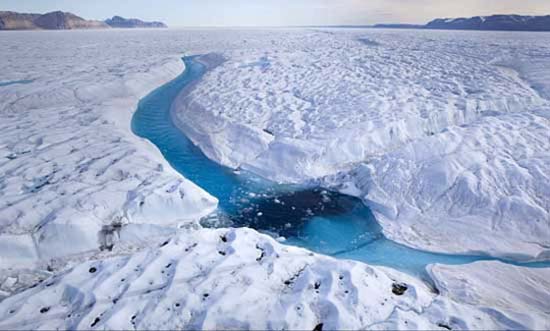North Atlantic ocean currents heat the Arctic
Moving between Greenland and Norway, the North Atlantic ocean currents carrying the warmest stream of water in the last 2,000 years are being blamed for accelerating the rate of destruction for the Arctic sea ice.

The sea ice in the arctic
That is the conclusion of the international team of experts according to the Science report last week.
They recorded a change in temperature when studying the carbonate of tiny plankton present in the seabed at Eo Fram, off Western Svalbard Island.
Through the study, team leader Robert Spielhagen, worked at the Institute of Humanities and Sciences in Mainz , Germany and discovered the ocean currents called Arctic Atlantic Water Layer (AAWL) not only record warmth in the past 20 centuries but it also carries a huge amount of water.
" Both effects - from rising temperatures to high volumes of water - poured a large amount of heat into the Arctic Sea. Although there is no direct contact between AAWL and the Arctic sea surface, an increase in Such a large amount of warm water still leads to incalculable consequences , 'according to a report on Science.
Eo Fram water has warmed 3.5 degrees Fahrenheit (-15.83 degrees Celsius) in the last century, the increase in heat that Spielhagen experts call is very different in all climate change events in 2,000. years ago. In fact, Greenland's air temperature increased by about 7 degrees F (-13.89 degrees C) for several hundred years.
In the joint statement of the University of Colorado-Boulder, the National Snow and Ice Data Center (USA), it was estimated that between 1979 and 2009, the Arctic sea ice lost an area that was larger than the largest state of America is Alaska (1.71 million km2).
Experts from Thomas Marchitto of the University of California, co-author of the study, said cold seawater plays an important role in the formation of ice, and in contrast, ice sea helps to cool the Earth by reflection. Light returns to the universe.
" The ice sea also allows Arctic air temperatures to stay at a cool level by forming an insulating blanket on the ocean. Warm water can lead to horrific consequences of melting ice here. " , Marchitto said.
- New discovery about the role of the ocean with climate
- The Atlantic will be
- The Arctic Sea is the hottest 2,000 years
- The only mystery about the sea is not in the world
- Pull the ice from the North Pole to Africa
- Water in the Indian Ocean flows into the Atlantic Ocean
- Will Europe be colder?
- Fluctuations in ocean currents can affect the Earth's climate
- 'Doomsday' comes true: the ocean is paralyzed, bringing the Earth back to the Ice Age?
- Perennial ice in the Arctic is disappearing
- When the Greenland ice melts ...
- The sea is hot to the extinct North Atlantic whale
 'Fine laughs' - Scary and painful torture in ancient times
'Fine laughs' - Scary and painful torture in ancient times The sequence of numbers 142857 of the Egyptian pyramids is known as the strangest number in the world - Why?
The sequence of numbers 142857 of the Egyptian pyramids is known as the strangest number in the world - Why? History of the iron
History of the iron What is alum?
What is alum?